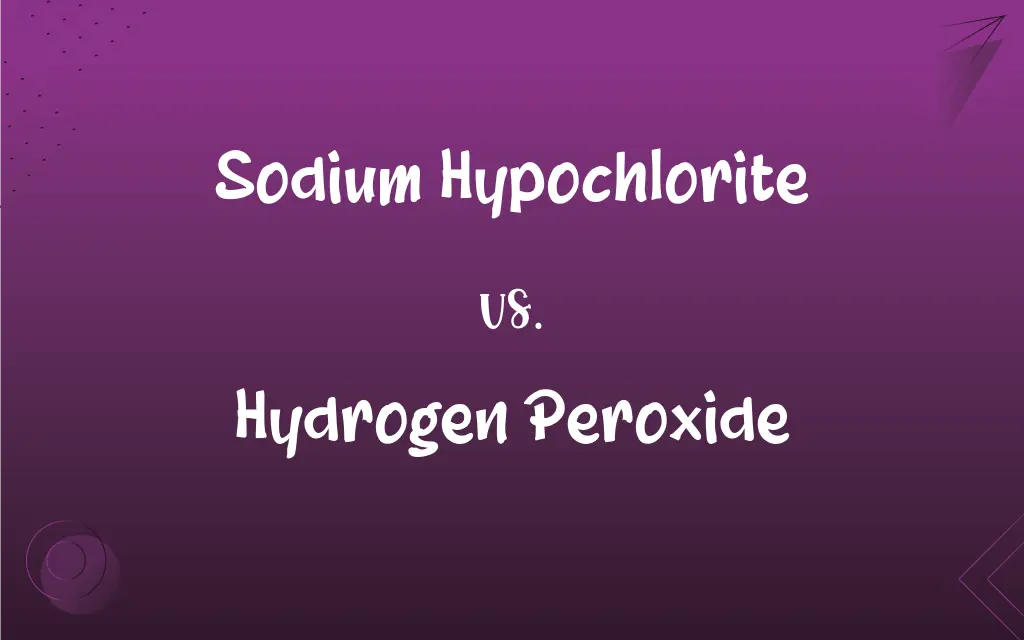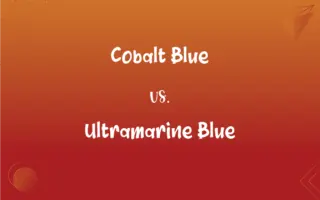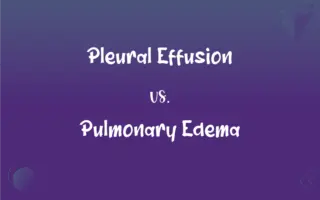Sodium Hypochlorite vs. Hydrogen Peroxide: What's the Difference?
Edited by Aimie Carlson || By Harlon Moss || Published on November 11, 2024
Sodium hypochlorite is a chlorine-based compound used as a disinfectant, while hydrogen peroxide is an oxygen-based compound with bleaching and antiseptic properties.

Key Differences
Sodium hypochlorite (NaOCl) and hydrogen peroxide (H2O2) are widely used for their disinfecting and bleaching abilities, but they operate through different chemical mechanisms. Sodium hypochlorite is a chlorine-releasing compound, effective against a broad range of microorganisms and is commonly found in bleach. Hydrogen peroxide, an oxidizing agent, releases oxygen upon decomposition, offering antiseptic and bleaching effects without chlorine's residues or odors.
Sodium hypochlorite's effectiveness as a disinfectant is due to its ability to disrupt the cell walls of bacteria and denature proteins, making it a staple in household cleaners and water treatment. Hydrogen peroxide, by releasing oxygen, creates an environment inhospitable to anaerobic bacteria and viruses, and its decomposed byproduct (water) makes it a safer option for various surfaces and fabrics.
The stability of these compounds varies; sodium hypochlorite breaks down when exposed to light and air, requiring careful storage. Hydrogen peroxide is more stable but can decompose rapidly in the presence of light or catalytic substances, necessitating dark, cool storage conditions.
In terms of safety, both chemicals can be hazardous at high concentrations. Sodium hypochlorite can cause irritation to skin and mucous membranes and degrade to release chlorine gas. Hydrogen peroxide, especially in higher concentrations, can cause burns and is toxic if ingested.
Choosing between sodium hypochlorite and hydrogen peroxide depends on the application's requirements, considering factors such as the targeted microorganisms, the presence of organic material, and safety concerns. Sodium hypochlorite is preferred for heavy-duty disinfection and water treatment, while hydrogen peroxide is favored for its milder impact and versatility in healthcare settings and as a household cleaner.
ADVERTISEMENT
Comparison Chart
Chemical Nature
Chlorine-based compound
Oxygen-based compound
Disinfection Mechanism
Disrupts cell walls, denatures proteins
Releases oxygen, creating an inhospitable environment for anaerobes
Common Uses
Bleach, water treatment, household cleaners
Antiseptic, bleach, wound cleaning, household cleaners
Stability
Breaks down in light and air
Decomposes in light or with catalytic substances
Safety Concerns
Skin/mucous membrane irritation, chlorine gas release
Can cause burns, toxic if ingested
ADVERTISEMENT
Sodium Hypochlorite and Hydrogen Peroxide Definitions
Sodium Hypochlorite
Requires careful storage to prevent decomposition.
Storing bleach in a cool, dark place.
Hydrogen Peroxide
An oxygen-based compound with antiseptic properties.
Using hydrogen peroxide to clean a cut.
Sodium Hypochlorite
Used in heavy-duty disinfection tasks.
Sanitizing swimming pools to prevent algae and bacteria.
Hydrogen Peroxide
Can cause burns at high concentrations.
Handling concentrated hydrogen peroxide with care.
Sodium Hypochlorite
Effective against a wide range of microorganisms.
Treating water to make it safe for drinking.
Hydrogen Peroxide
Versatile in healthcare and as a household cleaner.
Bleaching hair or disinfecting toothbrushes.
Sodium Hypochlorite
Can cause irritation and release chlorine gas.
Caution required when mixing bleach with acids.
Hydrogen Peroxide
Stable in dark, cool conditions but decomposes easily.
Keeping hydrogen peroxide in its original brown bottle.
Sodium Hypochlorite
A chlorine-based disinfectant used in bleach.
Cleaning a kitchen counter with bleach to kill bacteria.
Hydrogen Peroxide
Decomposes into water and oxygen, leaving no harmful residues.
Disinfecting surfaces without leaving a toxic residue.
FAQs
How do sodium hypochlorite and hydrogen peroxide differ in their disinfection mechanisms?
Sodium hypochlorite disrupts cell walls and denatures proteins, while hydrogen peroxide releases oxygen to create an inhospitable environment for anaerobic microorganisms.
Are sodium hypochlorite and hydrogen peroxide safe for all types of surfaces?
Both can be used on many surfaces, but care should be taken as sodium hypochlorite can bleach or damage certain materials, and hydrogen peroxide may also cause damage at higher concentrations.
What is sodium hypochlorite?
Sodium hypochlorite is a chlorine-based compound, primarily used as a disinfectant and bleaching agent in household and industrial settings.
Which is better for disinfecting wounds, sodium hypochlorite or hydrogen peroxide?
Hydrogen peroxide is typically used for cleaning wounds due to its antiseptic properties and decomposition into harmless byproducts, whereas sodium hypochlorite is generally not recommended for direct application to wounds.
How should sodium hypochlorite and hydrogen peroxide be stored?
Sodium hypochlorite should be stored in a cool, dark place away from acids, and hydrogen peroxide in its original dark container to prevent decomposition.
Can either sodium hypochlorite or hydrogen peroxide be used in organic farming?
Hydrogen peroxide is sometimes used in organic farming under specific conditions due to its decomposition into water and oxygen, while sodium hypochlorite is generally not used due to its chlorine content.
How does temperature affect the efficacy of sodium hypochlorite and hydrogen peroxide?
The disinfecting power of sodium hypochlorite can decrease at higher temperatures as it decomposes faster, whereas hydrogen peroxide's efficacy can increase with temperature as the rate of microbial cell destruction accelerates. However, very high temperatures can also accelerate the decomposition of hydrogen peroxide, reducing its shelf life and effectiveness.
What is hydrogen peroxide?
Hydrogen peroxide is an oxygen-releasing compound, used as an antiseptic, bleach, and in various cleaning applications.
Can sodium hypochlorite and hydrogen peroxide be mixed together for enhanced disinfection?
No, mixing them can be dangerous as they can react to form hazardous gases or compounds.
What are the environmental impacts of using sodium hypochlorite and hydrogen peroxide?
Sodium hypochlorite can release chlorine gas and other byproducts, potentially harmful to the environment. Hydrogen peroxide decomposes into water and oxygen, presenting less risk to environmental health.
Is there any resistance development in microorganisms against sodium hypochlorite or hydrogen peroxide?
While some bacteria can develop resistance mechanisms against certain disinfectants, widespread resistance to sodium hypochlorite and hydrogen peroxide is less common due to their broad mechanism of action that targets fundamental biological processes.
What precautions should be taken when using sodium hypochlorite or hydrogen peroxide?
Wear protective gloves and ensure good ventilation to avoid inhalation or skin contact. Avoid mixing with other chemicals, especially acids with sodium hypochlorite, to prevent hazardous reactions.
How do sodium hypochlorite and hydrogen peroxide react with organic material?
Sodium hypochlorite can react with organic material to form chlorinated compounds, some of which may be toxic. Hydrogen peroxide, when it comes into contact with organic material, can foam as it decomposes, releasing oxygen and potentially degrading organic substances without forming harmful byproducts.
Can sodium hypochlorite or hydrogen peroxide be used in food processing plants?
Yes, both can be used for sanitizing surfaces in food processing plants. Hydrogen peroxide is often preferred for its residue-free decomposition, especially in applications where food contact is possible. Sodium hypochlorite must be used with care to avoid contaminating food with chlorine residues.
What are the best practices for disposing of sodium hypochlorite and hydrogen peroxide solutions?
Disposal practices depend on local regulations. Generally, small quantities can be diluted with water and flushed down the drain with plenty of water. For larger quantities or higher concentrations, it's important to consult local environmental protection guidelines to ensure proper disposal and minimize environmental impact.
What is the impact of pH on sodium hypochlorite and hydrogen peroxide stability and activity?
The activity of sodium hypochlorite is optimal at a pH of around 7, as it becomes less stable and decomposes more rapidly in acidic or highly alkaline conditions. Hydrogen peroxide is relatively stable across a broad pH range, but acidic conditions can increase its decomposition rate, especially in the presence of catalysts.
Are there any specific industries where sodium hypochlorite is preferred over hydrogen peroxide?
Sodium hypochlorite is often preferred in the water treatment industry for disinfecting large volumes of water, such as in swimming pools and drinking water supplies, due to its potent antimicrobial effects and cost-effectiveness at scale.
Can sodium hypochlorite and hydrogen peroxide be used for mold and mildew removal?
Yes, both chemicals can be effective against mold and mildew. Sodium hypochlorite is commonly used for its strong bleaching action on hard, non-porous surfaces, while hydrogen peroxide can be used on a variety of surfaces, including fabrics, without leaving harmful residues.
What concentrations of hydrogen peroxide are typically used for disinfection?
For household disinfection, concentrations of 3% to 6% are commonly used. Higher concentrations (up to 35%) may be used in industrial or medical settings, but with increased safety precautions.
How do environmental regulations affect the use of sodium hypochlorite and hydrogen peroxide?
Environmental regulations may limit the concentrations and methods of disposal for both chemicals due to their potential impact on aquatic life and the environment. Hydrogen peroxide, being less harmful, may face fewer restrictions compared to sodium hypochlorite, which can produce toxic byproducts.
About Author
Written by
Harlon MossHarlon is a seasoned quality moderator and accomplished content writer for Difference Wiki. An alumnus of the prestigious University of California, he earned his degree in Computer Science. Leveraging his academic background, Harlon brings a meticulous and informed perspective to his work, ensuring content accuracy and excellence.
Edited by
Aimie CarlsonAimie Carlson, holding a master's degree in English literature, is a fervent English language enthusiast. She lends her writing talents to Difference Wiki, a prominent website that specializes in comparisons, offering readers insightful analyses that both captivate and inform.







































































